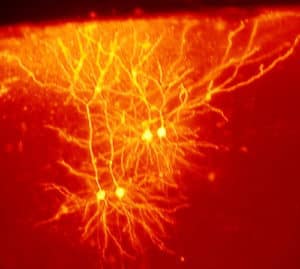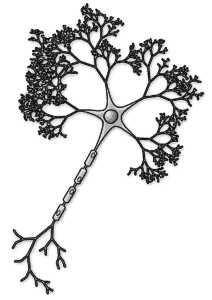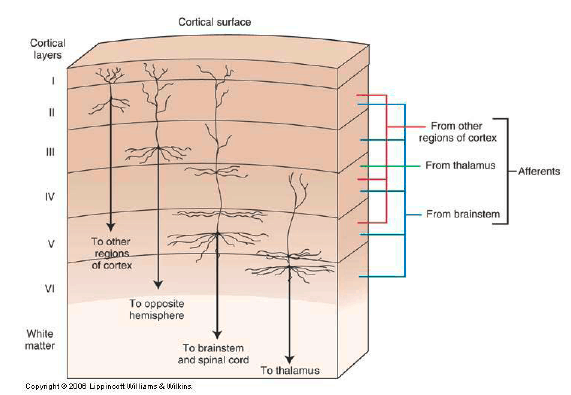Neurons are the information-processing components of the nervous system. Mental Construction focuses on neural actions in the brain, not on neurons in the periphery or spinal column.
Before we get blown away by the immense complexity of the entire brain with its 100 billion neurons and numerous trillions of interconnections, let’s establish the fundamentals that are known to apply to each neuron.
Figure 7.1 of a section of a mouse’s cortex, with a million-fold less neurons than humans. The brightest spots are the neural soma, their cell bodies. The large number of connections, even in this small slice, is daunting to conceptualize.
Figure 7.2 is a standard tree schematic of a cortical neuron. The neural soma is the in the center with the enclosed circle. The 4 short branches off the soma terminate with the profusion of connections, are dendritic inputs. The fifth long branch is the single axon output. The sausage-like segments along the axon are connected at nodes of Ranvier at which the axon signal is regenerated, maintaining it. Near the terminus of the axon, a number of branches sprout, delivering the axon’s signal to multiple neurons.
Finally, in Figure 7.3, the neuron’s are labeled with as simply as possible.

The three significant physical features that Mental Construction concentrates on:
- Dendrites are input sources. Dendrites bring electrical charges in from sensory cells and other neurons. A cortical neuron has 10,000 dendrites on average. They carry information in the form of electrical potentials. Those charges come in two flavors—excitatory and inhibitory. Positive potentials are excitatory (averaging 7,000), while negative potentials are inhibitory (averaging 3,000).
- Soma is the main body of the neuron where the aggregation of all the dendrite electrical potential is performed. Although I am focusing on the summation only, neuroscientists have discovered that the frequency and timing of the inputs are also important to the neural threshold firing.
- An axon propagates an electrical potential down its length, whenever the neuron’s threshold is exceeded. At its end, the axon splinters to terminals knobs. Each knob delivers the full axon potential to the synapse of receiving neurons.
Axons have two basic connection styles:
- First, local connections for performing processing. These are direct, unmyelinated (uninsulated) connections to nearby neurons. This connection is diffuse and slow. The electrical charge can dissipate as it flows down a long axon.
- Second, connections between separated areas of the cortex, for exchanging category information derived by local modules. Myelin sheath coats the axon, insulating the connection. At the nodes of Ranvier, the signal is regenerated, akin to the work of repeaters in the long-distance communication industry. This allows axon to send signals to relatively remote brain areas with fidelity and speed that is 10 to 100 times faster than in unmyelinated axons. The significant consequences of myelin in critical stages of learning are discussed in the development of the adult mind.
Synapse Connection
The sending axon of the first neuron reaches a gap that separates the axon from the receiving neuron, called the synapse. On the synaptic gap’s other side is a receiving dendrite of another neuron.
The synaptic gap (Figure 7.4) is the name of the locale where an axon terminal chemically communicates with a different neuron’s receiving dendrite. The electrical potential from the sending axon arrives at full strength; however, the chemical effectiveness of the transfer is modifiable. It is weighted – made more or less efficient, by repeated experiences of the synapse in prior occurrences. That might sound mystical, but it is explained by Hebb’s Law and Long-Term Potentiation.
Hebb’s Law was a postulate, but has since been experimentally confirmed notably by Eric Kandel (Nobel Prize 2000).When an axon of cell A is near enough to excite B and repeatedly or persistently takes part in firing it, some growth process or metabolic change takes place in one or both cells such that A’s efficiency, as one of the cells firing B, is increased.
Long-Term Potentiation (LTP) as described by James Kalat (p 410).One or more axons connected to some dendrite bombard it with a brief but rapid series of stimuli- such as 100 synaptic excitations per second for 1 to 4 seconds. This burst leaves some synapses potentiated (more responsive to new input of the same type) for minutes, days, or weeks.
The modification of the magnitude of transmission across the synaptic gap underlay the formation of sensory and semantic maps in the brain.
The axon leaves its neuron as a single thread with a set amount of electric potential—either Off (0 mV) or On (35–50 mV) The precise On value, the action potential, varies according to a person’s genetic makeup.
Axons have two basic connection modes.
- First, local connections for performing processing. These are direct, unmyelinated (uninsulated) connections to nearby neurons. This connection is diffuse and slow. The electrical charge can dissipate as it flows down a long axon.
- Second, connections between separated areas of the cortex, for exchanging category information derived by local modules. Myelin sheath coats the axon, insulating the connection. At the nodes of Ranvier, the signal is regenerated, akin to the work of repeaters in the long-distance communication industry. This allows axon to send signals to relatively remote brain areas with fidelity and speed that is 10 to 100 times faster than in unmyelinated axons. The significant consequences of myelin in critical stages of learning are discussed in the development of the adult mind.
Cortical Regularities
The cortex has a general uniformity. More than 90% of the human cortex is six layers deep with the layer functionality dependent on the vertical location. Neurons receiving inputs from other areas clustered in same layer throughout the cortex. Those sending outputs clustered on another layer. (Spitzer p 91). Drawing from information Kalat provides in Biological Psychology (p 95) sensory information arrives at layer IV and motor output is sent through layer V.Winning Neuron and Synaptic Weightings
Information in the brain is stored not just in the neuron that fires, but in the weights (the efficiencies) set at the synapses. This will become clearer when we consider groups of neurons and how they categorize information into memory maps. It is important to note that these synaptic weightings are shared by multiple distinct inputs. That implies that each input will affect the aggregation of electrical potentials for all inputs that travel the same neural paths, even inputs already learned.
Next, let’s discuss the important, consequential properties of the Neural Threshold.



